1998 GMC SIERRA maintenance
[x] Cancel search: maintenancePage 303 of 452
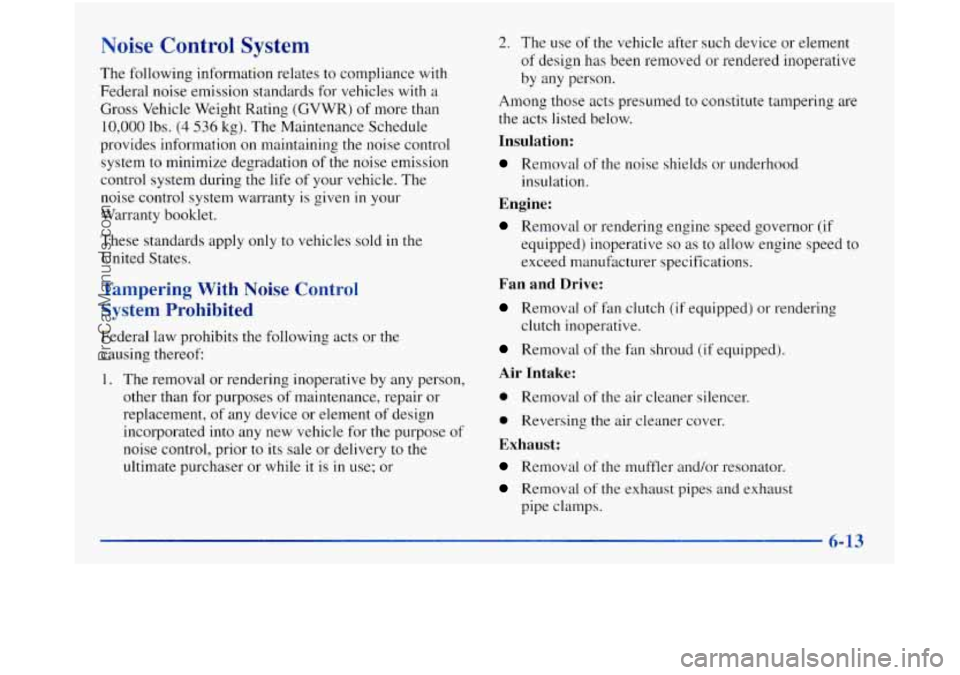
Noise Control System
The following information relates to compliance with
Federal noise emission standards for vehicles with a
Gross Vehicle Weight Rating (GVWR) of more than
10,000 lbs. (4 536 kg). The Maintenance Schedule
provides information on maintaining the noise control
system to minimize degradation of the noise emission
control system during the life of your vehicle. The
noise control system warranty is given
in your
Warranty booklet.
These standards apply only to vehicles sold
in the
United States.
Tampering With Noise Control
System Prohibited
Federal law prohibits the following acts or the
causing thereof:
1. The removal or rendering inoperative by any person,
other than for purposes
of maintenance, repair or
replacement,
of any device or element of design
incorporated into any new vehicle for the purpose of
noise control, prior to its sale or delivery to the
ultimate purchaser or while
it is in use; or
2. The use of the vehicle after such device or element
of design has been removed or rendered inoperative
by any person.
Among those acts presumed to constitute tampering are
the acts listed below.
Insulation:
Removal of the noise shields or underhood
insulation.
Engine:
Removal or rendering engine speed governor (if
equipped) inoperative
so as to allow engine speed to
exceed manufacturer specifications.
Fan and Drive:
Removal of fan clutch (if equipped) or rendering
clutch inoperative.
Removal of the fm shroud (if equipped).
Air Intake:
0 Removal of the air cleaner silencer.
0 Reversing the air cleaner cover.
Exhaust:
Removal of the muffler and/or resonator.
Removal of the exhaust pipes and exhaust
pipe clamps.
ProCarManuals.com
Page 307 of 452
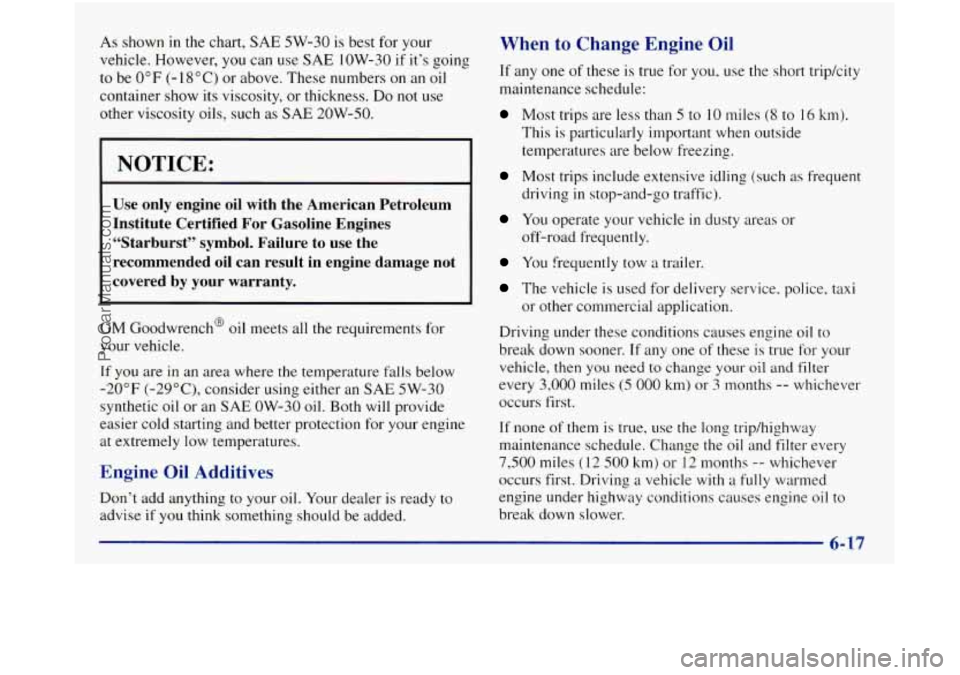
As shown in the chart, SAE 5W-30 is best for your
vehicle. However,
you can use SAE 1OW-30 if it’s going
to be
0°F (- 18 “C) or above. These numbers on an oil
container show
its viscosity, or thickness. Do not use
other viscosity oils, such
as SAE 20W-50.
NOTICE:
Use only engine oil with the American Petroleum
Institute Certified For Gasoline Engines “Starburst” symbol. Failure to use the
recommended oil can result in engine damage not
covered by your warranty.
GM Goodwrench@ oil meets all the requirements for
your vehicle.
If you are in an area where the temperature falls below
-20°F (-29°C)’ consider using either an SAE 5W-30
synthetic oil or an
SAE OW-30 oil. Both will provide
easier cold starting and better protection for your engine
at extremely low temperatures.
Engine Oil Additives
Don’t add anything to your oil. Your dealer is ready to
advise if
you think something should be added.
When to Change Engine Oil
If any one of these is true for you, use the short tripkity
maintenance schedule:
Most trips are less than 5 to 10 miles (8 to 16 km).
This is particularly important when outside
temperatures are below freezing.
Most trips include extensive idling (such as frequent
driving
in stop-and-go traffic).
You operate your vehicle in dusty areas or
off-road frequently.
You frequently tow a trailer.
The vehicle is used for delivery service, police, taxi
or other commercial application.
Driving under these conditions causes engine
oil to
break down sooner.
If any one of these is true for your
vehicle,
then you need to change your oil and filter
every
3,000 miles (5 000 km) or 3 months -- whichever
occurs first.
If none of them is true, use the long trip/highway
maintenance schedule. Change the oil and filter every
7,500 miles (12 500 km) or 12 months -- whichever
occurs first. Driving a vehicle with
a fully warmed
engine under highway conditions causes engine
oil to
break down slower.
6-S7
ProCarManuals.com
Page 310 of 452
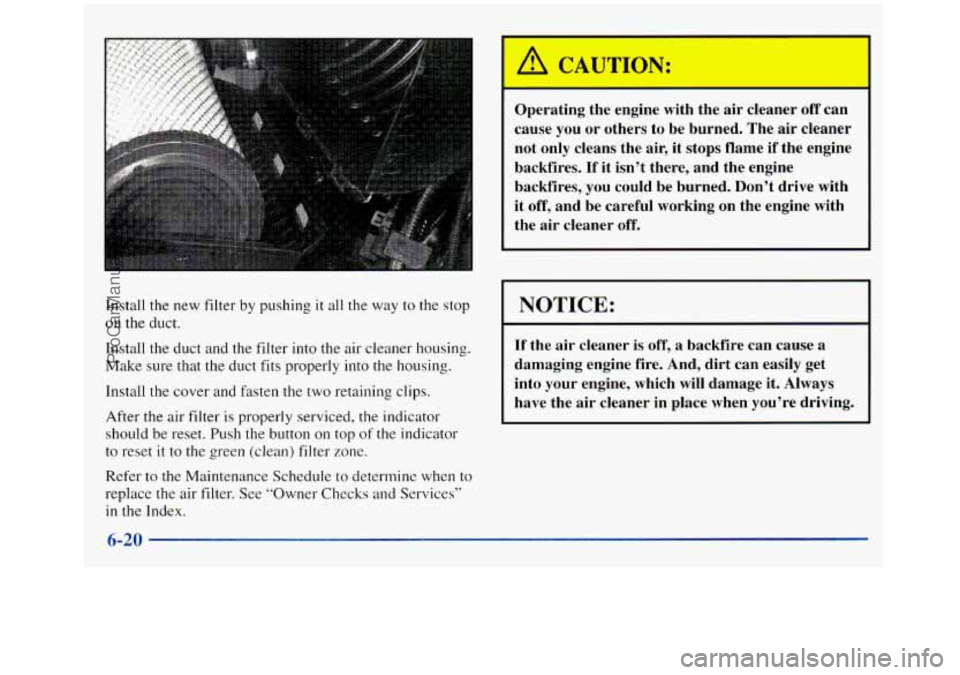
Install the new filter by pushing it all the way to the stop
on the duct.
Install the duct and the filter into the air cleaner housing.
Make sure that the duct fits properly into the housing.
Install the cover and fasten the two retaining clips.
After the air filter
is properly serviced, the indicator
should be reset. Push the button on top
of the indicator
to reset it to the green (clean) filter
zone.
Refer to the Maintenance Schedule to determine when to
replace the air filter. See “Owner Checks and Services”
in the Index.
A CAUTION:
Operating the engine with the air cleaner off can
cause you or others
to be burned. The air cleaner
not only cleans the air, it stops flame if the engine
backfires.
If it isn’t there, and the engine
backfires, you could be burned. Don’t drive with
it
off, and be careful working on the engine with
the air cleaner off.
I NOTICE:
If the air cleaner is off, a backfire can cause a
damaging engine fire. And, dirt can easily get
into your engine, which will damage it. Always
have the air cleaner in place when you’re driving.
6-20
ProCarManuals.com
Page 311 of 452
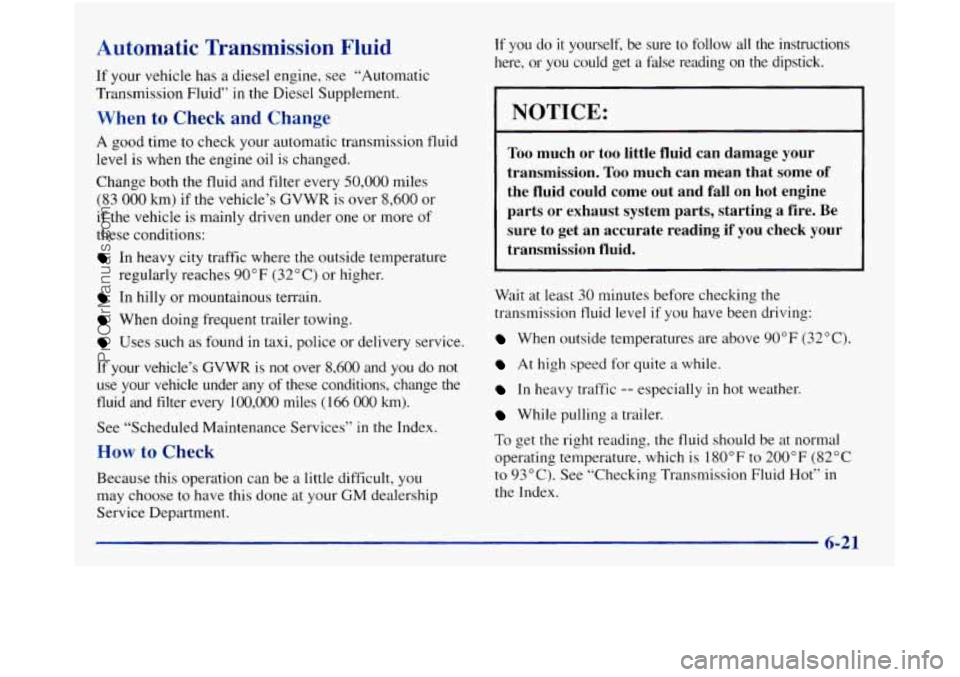
Automatic Transmission Fluid
If your vehicle has a diesel engine, see “Automatic
Transmission Fluid”
in the Diesel Supplement.
When to Check and Change
A good time to check your automatic transmission fluid
level is when the engine oil is changed.
Change both the fluid and filter every
50,000 miles
(83
000 km) if the vehicle’s GVWR is over 8,600 or
if the vehicle is mainly driven under one or more of
these conditions:
In heavy city traffic where the outside temperature
In hilly or mountainous terrain.
When doing frequent trailer towing.
Uses such as found in taxi, police or delivery service.
regularly
reaches
90°F (32°C) or higher.
If your vehicle’s GVWR is not over 8,600 and you do not
use your vehicle under any
of these conditions, change the
fluid and filter every
100,000 miles (166 000 km).
See “Scheduled Maintenance Services’’ in the Index.
How to Check
Because this operation can be a little difficult, you
may choose to have this done at your
GM dealership
Service Department.
If you do it yourself, be sure to follow all the instructions
here, or you could get a false reading on the dipstick.
NOTICE:
Too much or too little fluid can damage your
transmission.
Too much can mean that some of
the fluid could come
out and fall on hot engine
parts or exhaust system parts, starting a fire.
Be
sure to get an accurate reading if you check your
transmission fluid.
Wait at least 30 minutes before checking the
transmission fluid level if you have been driving:
When outside temperatures are above 90°F (32°C).
At high speed for quite a while.
In heavy traffic -- especially in hot weather.
While pulling a trailer.
To get the right reading, the fluid should be at normal
operating temperature, which is
180°F to 200°F (82°C
to 93°C). See “Checking Transmission Fluid Hot“ in
the Index.
6-21
ProCarManuals.com
Page 313 of 452
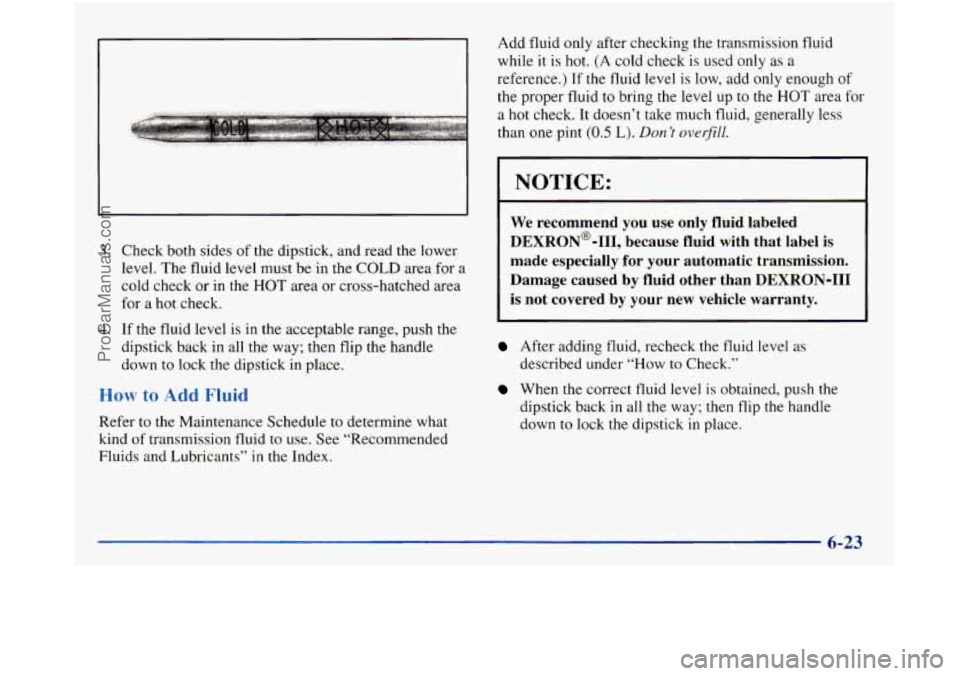
3. Check both sides of the dipstick, and read the lower
level. The fluid level must be in the COLD area for a
cold check or in the
HOT area or cross-hatched area
for a
hot check.
4. If the fluid level is in the acceptable range, push the
dipstick back in all the way; then flip the handle
down
to lock the dipstick in place.
io dd Fluid
Refer to the Maintenance Schedule to determine what
kind
of transmission fluid to use. See “Recommended
Fluids and Lubricants”
in the Index. Add
fluid only after checking the transmission fluid
while
it is hot. (A cold check is used only as a
reference.)
If the fluid level is low, add only enough of
the proper fluid
to bring the level up to the HOT area for
a hot check. It doesn’t take much fluid, generally less
than one pint
(0.5 L). Don’t overfill.
I NOTICE:
We recommend you use only fluid labeled
DEXRON@-111, because fluid with that label is
made especially for your automatic transmission.
Damage caused by fluid other than DEXRON-111
is not covered by your new vehicle warranty.
After adding fluid, recheck the fluid level as
described under “How to Check.”
When the correct fluid level is obtained, push the
dipstick back
in all the way; then flip the handle
down to lock the dipstick
in place.
6-23
ProCarManuals.com
Page 315 of 452
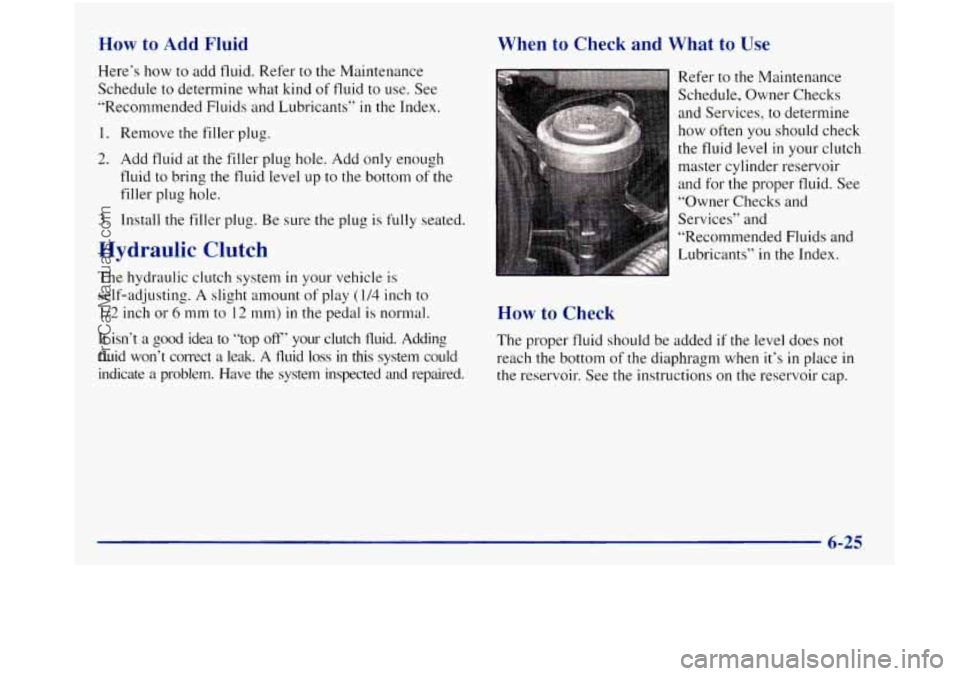
How to Add Fluid
Here’s how to add fluid. Refer to the Maintenance
Schedule to determine what kind of fluid to use. See
”Recommended Fluids and Lubricants”
in the Index.
1. Remove the filler plug.
2. Add fluid at the filler plug hole. Add only enough
fluid to bring the tluid level up to the bottom of the
filler plug hole.
3. Install the filler plug.
Be sure the plug is fully seated.
Hydraulic Clutch
The hydraulic clutch system in your vehicle is
self-adjusting. A slight amount of play (1/4 inch to
1/2 inch or 6 lnm to 12 mm) in the pedal is normal.
It isn‘t a good idea to “top off’ your clutch fluid. Adding
fluid won’t correct a leak.
A fluid loss in this system could
indicate a problem. Have
the system inspected and repaired.
When to Check and What to Use
Refer to the Maintenance
Schedule, Owner Checks
and Services,
to determine
how often you should check
the fluid level
in your clutch
master cylinder reservoir
and for the proper fluid. See
“Owner Checks and
Services” and
“Recommended Fluids and
Lubricants” in the Index.
How to Check
The proper fluid should be added if the level does not
reach the bottom
of the diaphragm when it’s in place in
the reservoir. See the instructions on the reservoir cap.
6-25
ProCarManuals.com
Page 316 of 452
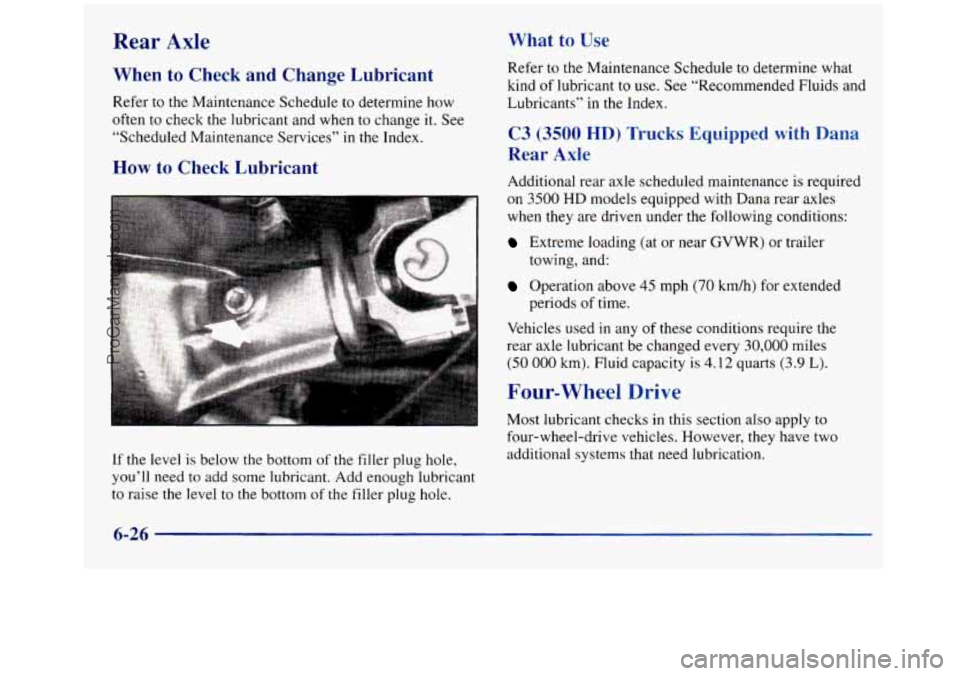
Rear Axle
When to Check and Change Lubricant
Refer to the Maintenance Schedule to determine how
often to check
the lubricant and when to change it. See
“Scheduled Maintenance Services” in the Index.
How to Check Lubricant
If the level is below the bottom of the filler plug hole,
you’ll need to add some lubricant.
Add enough lubricant
to raise the level to the bottom
of the filler plug hole.
What to Use
Refer to the Maintenance Schedule to determine what
kind of lubricant
to use. See “Recommended Fluids and
Lubricants”
in the Index.
C3 (3500 HD) Trucks Equipped with Dana
Rear
Axle
Additional rear axle scheduled maintenance is required
on
3500 HD models equipped with Dana rear axles
when they are driven under the following conditions:
Extreme loading (at or near GVWR) or trailer
Operation above 45 mph (70 km/h) for extended
Vehicles used in any of these conditions require the
rear axle lubricant be changed every
30,000 miles
(50 000 km). Fluid capacity is 4.12 quarts (3.9 L).
towing, and:
periods of time.
Four-wheel Drive
Most lubricant checks in this section also apply to
four-wheel-drive vehicles. However, they have two
additional systems that need lubrication.
6-26
ProCarManuals.com
Page 317 of 452
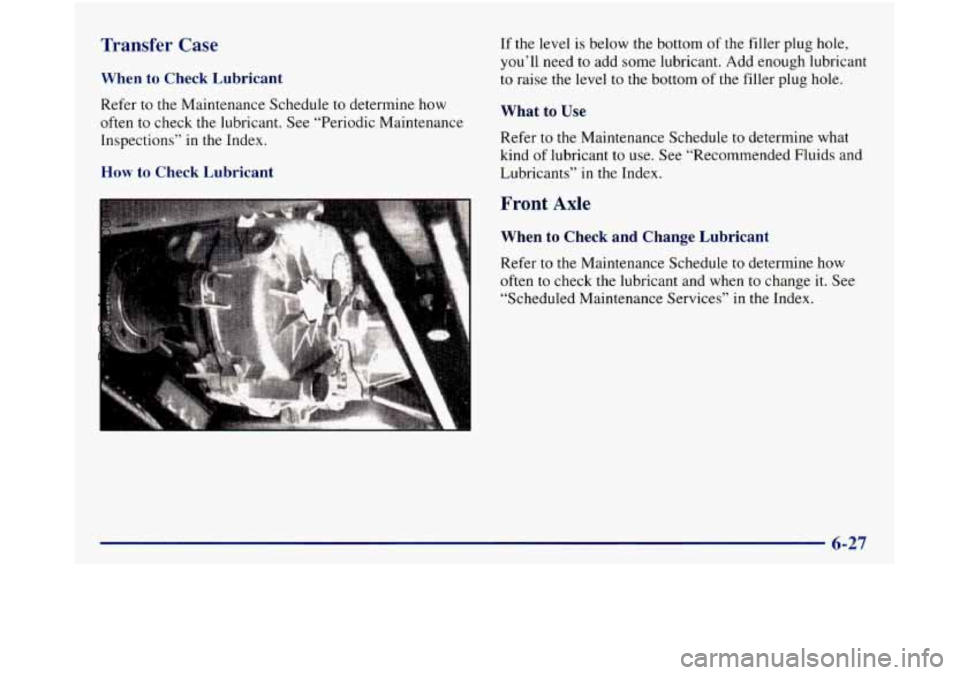
Transfer Case
When to Check Lubricant
Refer to the Maintenance Schedule to determine how
often to check
the lubricant. See “Periodic Maintenance
Inspections” in the Index.
How to Check I>--’- --’ :::It
If the level is below the bottom of the filler plug hole,
you’ll need to add some lubricant. Add enough lubricant
to raise the level to the bottom of the filler plug hole.
What to Use
Refer to the Maintenance Schedule to determine what
kind of lubricant to use. See “Recommended Fluids and
Lubricants” in the Index.
Front Axle
When to Check and Change Lubricant
Refer to the Maintenance Schedule to determine how
often to check the lubricant and when to change
it. See
“Scheduled Maintenance Services”
in the Index.
ProCarManuals.com